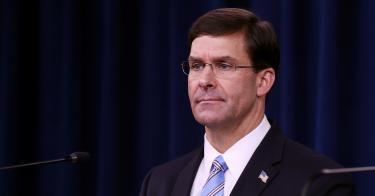For too long, the U.S. has lived off the dividends of its Cold War investments. Consider its Navy.
In the first years following the Soviet Union's dissolution, the nation closed four public shipyards and rapidly reduced the fleet by over 137 ships. Now, however, with the resurgence of Russia and an assertive China, it is a trend the Secretary of Defense Mark Esper is working hard to reverse.
>>> A Conversation with Secretary of Defense Mark Esper on the Readiness of the U.S. Armed Forces
On October 6, Esper channeled the great naval thinker Alfred Thayer Mahan at a fireside chat, making a persuasive case that things must change. His call for upwards of 500 ships, including numerous unmanned platforms and new classes of warships, is welcome. It represents one part of a wider effort to bend trend-lines towards a revitalized Navy for great power competition.
While a formal 30-year shipbuilding plan and Future Naval Force Study are still not available to review, the Secretary’s comments gave us indications of what to expect in those documents. In the new plan, “Battle Force 2045,” Esper said a top priority will be producing more nuclear attack submarines at a rate of three a year. The goal: a fleet of 70 to 80 submarines, while at the same time ensuring on-time delivery of the Columbia-class next-generation strategic missile submarines—the most survivable leg of the nation's strategic deterrent triad.
This logic is indisputable. Both of these systems are essential and represent a U.S. comparative advantage in contesting a formidable maritime adversary such as China.
Esper also called for expanding the Navy’s numbers in small combatants like frigates. His call for at least 500 ships includes upwards of 240 unmanned and optionally manned ships. The larger numbers are important; they mitigate the loss of one of the fewer but larger warships and complicate an adversary’s defenses.
Unmentioned, however, was the added cost in support ships, trained maintainers, and operators this growing unmanned fleet would require. How the Navy scales up a trained workforce in tandem with increased production of these new platforms will be a critical element of Battle Force 2045's success.
Most controversial, given past Congressional mandates, was Esper’s call for up to six light aircraft carriers to augment a smaller fleet (i.e., fewer than today’s 11) of Nimitz and Ford-class nuclear aircraft carriers. Little was divulged on the design, but past studies—such as RAND's 2017 report on alternative carrier designs—provide valuable insight. Those insights, such as de-emphasizing sortie generation rates (i.e., faster aircraft recovery and launching turnaround rate), will need to be refreshed as the operational concepts have changed, and carrier air operations evolve as more unmanned planes are fielded.
Details remain limited, but producing a new light carrier to alleviate demands on larger nuclear-powered aircraft carriers is too narrowly focused when it has promise in executing new missions. For example, it is expected that the Navy will support the Marines and the Army deploying anti-access weapons (i.e., surface-to-air and anti-surface missiles) along China's maritime periphery in the first island chain. Survival of these forces and their logistic network amid dense Chinese offensive capabilities requires a platform able to locate and clear a wide area of threats quickly—a mission not well suited to submarines.
A light aircraft carrier designed to operate in this highly contested maritime environment—East and South China Seas, fits the bill. If designed using existing propulsion systems, hull forms, and support systems, it may also bolster the Navy’s near-term forward presence. With this in mind, a light aircraft carrier could prove cost-effective and invaluable to the National Defense Strategy's success.
As the Secretary laid out again, this plan represents a significant change of Navy force design, necessitating new classes of warships to execute the Defense Department’s theory of victory. The underlying concepts are good (EABO, DMO, ADO), but without adequate protection and survivability, forces could be destroyed piecemeal.
Lastly, the Secretary acknowledged that the Navy needs a larger logistics fleet. While he stressed more work is needed, the goal will likely be a fleet of 70 to 90 logistics ships. Any increase over today’s 29 logistic ships would be welcome and overdue to enhance the Navy’s operational resilience.More needs to be said on the importance of the industrial capacity to reconstitute the fleet and sustain it with overseas bases. Additionally, given the Secretary’s emphasis on greater numbers of nuclear submarines, an immediate need will be expanding the capacity of public shipyards that sustain the nuclear navy—likely with the addition of a public shipyard on the West Coast.
Overall, the message has been consistent—the nation needs an invigorated national naval program. Flexible defense budgeting will play a key role, such as capital accounts and mechanisms to capture annual unspent monies for shipbuilding.
It is also important to note, Esper made clear: the current shipbuilding plan of 355 ships by 2035 stands even as the Navy would build Battle Force 2045. If accurate, this is good news given the uncertainty in production timelines of new ship designs while also delivering more ships today. It is also good news for shipbuilders, who rely on predictability, stability, and adequate intervals in construction to stay on budget and on time.
In the final analysis, what matters most is results measured in increased numbers of ships operating in decisive theaters of maritime operations. The sooner that can be achieved, the better. And that makes the Secretary’s recent comments heartening indeed.
This piece originally appeared in Real Clear Defense




